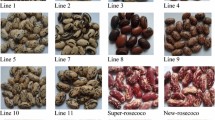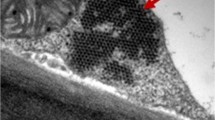Summary
Since there is now sufficient evidence regarding the symptoms of the most important bean diseases in Western Europe, these can serve as a basis for resistance testing. This study led to the development of testing methods which are useful for private breeders.
The resistance department of the Institute for Phytopathological Research (I.P.O.) gives information on this subject and supplies the infection material required.
Resistance-genes were traced by testing numerous cultivated varieties and wild species. In addition, more data became available concerning the inheritance of resistance, after testing numerous crosses at private breeding establishments and official plant breeding institutes.
The following diseases and testing methods are described:
-
1.
Common bean mosaic and black root. Phaseolus virus 1 Testing can be carried out by sowing in the second half of May or in the beginning of June. Seeds, infected with virus, should be sown next to beans to be tested, while a sufficient number of aphids should be available for the transmission of the virus. In the coastal areas of the Netherlands aphids are far less numerous, so it is generally necessary to test artificially by sap inoculation of the seedlings. Black root can only be transmitted in this way at temperatures above 30°C. Grafting of diseased material on to the plants to be tested is too laborious for private breeders, at least for the time being. Testing in the field for resistance to black root should be carried out all the same in the southern, central and eastern parts of the country.
-
2.
Yellow bean mosaic. Phaseolus virus 2 When a sufficient number of winged aphids is available, testing can be carried out by sowing beans next to rows of infected gladioli in the second half of May or in early June. Artificial inoculation of seedlings can be brought about by the use of sap.
-
3.
Stipple streak. Nicotiana virus 11 Apart from sowing in infested soil the plants can be tested by inoculating seedlings with diluted sap from diseased plants. A healthy and vigorous root system can be the proof of resistance provided that the aerial parts of the plant develop no disease symptoms.
-
4.
Halo blight. Pseudomonas phaseolicola (Burkh.) Dowson Seedlings or pods can be tested for resistance by four inoculation methods with a bacterial suspension of the causal organism. The most reliable estimation of resistance is based on the development of “greasy” spots on leaves and pods. The development of chlorotic “halo spots” is mainly dependent on a temperature of below 20°C since they are not caused by the bacteria themselves but by toxins which they excrete and which are apparently sensitive to temperature.
-
5.
Anthracnose. Colletotrichum lindemuthianum (Sacc et Magn.) Scrib. Seedlings can be tested in tubes with cotton wool plugs by inoculating with a suspension which, according to the resistance to be expected, contains spores of the different physiological races (alpha, beta, gamma anddelta). In order to allow the spores to germinate the inoculated plants are kept at 100% humidity for three days, maintaining a temperature of between 14°C and 22°C. Trays or boxes with seedlings are sealed with glass or plastic. Three days after inoculation the seal can be removed but the temperature should not vary much above or below the range mentioned. By potting up all plants tested after three days there is little risk of poor growth in consequence of bad root development. This is often the case when planting is done after the appearance of disease symptoms, especially when the beans are planted under field conditions. From table 3 it appears that it is often not possible to combine a sufficient number of resistance genes by making a single cross. Resistance to thedelta race of Colletotrichum should be derived fromhard shell beans which are partly susceptible to races against which resistance is easily to be found in varieties used in horticulture. Apart from aiming at complete resistance to anthracnose, new prospects of resistance breeding are possible through the inheritance of resistance. It appears that some 20 genes should be combined to attain resistance to the most important diseases including rust, for which so far in Europe no resistance-test has been evolved. Allowing these 20 genes to segregate freely would require an area three times that of the Netherlands in order to find a single plant with the desired features. By purposeful resistance-testing from the F2 onwards, the number of resistance genes can be raised gradually to such an extent that plants can be selected in which at least resistance to 4 diseases occurs. In order to reach resistance to 5 diseases, which is provisionally aimed at as a maximum, two lines of the F5 or F6 with comparable resistance factors should be crossed reciprocally. The lacking resistance genes of one of the lines should be compensated by resistance genes of the other line and vice versa.
Similar content being viewed by others
Literature
AliM. A., Genetics of resistence to the common bean mosaic virus (bean virus 1) in the bean. Phytopath. 40 (1950): 69–79.
AndersenA. L. & DownE. E., Inheritance of resistance to the variant strain of the common bean mosaic virus. Phytopath. 44 (1954): 481.
Andrus, C. F. & Wade, B. L., The factorial interpretation of anthracnose resistance in beans. Tech. Bull. U.S. Dep. Agric, Wash.810 (1942): 29 pp.
BaggettJ. R., The inheritance of resistance to strains of bean yellow mosaic virus in the interspecific crossPhaseolus vulgaris × P.coccineus. Plant Disease Reporter 40 (1956): 702–707.
Baur, E., Einführung in die experimentelle Vererbungslehre. Berlin. 1919.
BurkartA. & BrücherH.,Phaseolus aborigineus Burkart, die mutmassliche andine Stammform der Kulturbohne. Der Züchter 23 (1933): 65–72.
Buishand, Tj., Enige ervaringen met het veredelen van bonen (Phaseolus spp.). Meded. Proefst. Groenteteelt in de volle grond, Alkmaar,1 (1955): 48 pp., 23 figs.
Buishand, Tj., Rondom de teelt van stamslabonen. Meded. Proefst. Groenteelt in de volle grond, Alkmaar,4 (1956): 75 pp.
FisherH. H., New physiologic races of bean rust (Uromyces phaseoli typica). Plant Dis. Reptr. 36 (1952): 103–105.
FrandsenN. O., Untersuchungen zur Virusresistenzzüchtung beiPhaseolus vulgaris L. I. Phytopathologische Untersuchungen. Zeitschr. Pfl.züchtung 31 (1952): 381–420.
FrandsenN.O., Zur physiologischen Specialisierung vonColletotrichum lindemuthianum (Sacc. × Magn.) Bri. × Cav. Zeitschr. Pfl. Krankh. 60 (1953): 114–125.
GiessenA. C.van der and SteenbergenA.van, A new method of testing beans for anthracnose. Euphytica 6 (1957): 90–93.
GroganR. G. & WalkerJ. C., The relation of southern bean mosaic to black root. Journ. Agr. Res. 77 (1948): 315–331.
Hubbeling, N., Ziekten en beschadigingen van bonen. Bean diseases and pests. Tuinbouwvoorlichting3 (1955), 82 pp., 32 colourpl. Den Haag.
Hubbeling, N., Colourplates of bean defects. Fatis (Paris), in cooperation with the Netherlands Ministry of Agriculture, Fisheries and Food, 1956.
Hubbeling, N., Maladies et dégats du haricot, planches en couleur. Fatis. 1956.
Hubbeling, N., Krankheiten und Schäden der Gartenbohne, 32 farbige Bilder. Fatis. 1956.
Martinez SalazarE. and AndersenA. L., Effects of temperature on spore germination and host infectivity by three strains ofColletotrichum lindemuthianum. Phytopath. 47 (1957): 23. (Abstr.).
QuantzL., Über das Verhalten von Buschbohnensorten gegenüber den Bohnenmosaikviren 1 und 2. Nachrichtenblatt d.dtsch. Pflanzenschutzd. 5 (1953): 129–132.
Quantz, L., Viruskrankheiten der Hülsenfrüchte. Flugblatt76 der Biol. Bundesanst. f. Land-und Forstwirtsch. (1955) 8 pp.
QuantzL., Eine für Deutschland neue Viruskrankheit der Gartenbohne durch ein Tabaknekrose-Virus. Nachrichtenblatt des deutsch. Pflanzenschutzd. 8 (1956): 7–8.
QuantzL., Ein Schalentest zum Schnellnachweis des Gewöhnlichen Bohnenmosaikvirus (Phaseolus-virus 1). Nachrichtenblatt des deutsch. Pflanzenschutzd. 9 (1957): 71–74.
RichardsB. L. and MungerH. M., A rapid method for mechanically transmitting plant viruses. Phytopath. 34 (1944): 1010. (Abstr.).
Rudorf, W., Was bedeuten die Wildarten unserer Kulturpflanzen in der neuzeitlichen Pflanzenzüchtung? Vorträge Landw. Fakultät Univ. Bonn-Poppelsdorf (1952): 255 pp.
RudorfW., Die Übertragung der Resistenz gegen die Bohnenmosaik-Viren 1 (gewöhnliches Bohnenmosaik) und 2 (gelbes Bohnenmosaik) ausPhaseolus coccineus in fertile Bastardpflanzen aus der KreuzungP. vulgaris × P.coccineus. Naturwissenschaften 42: (1955): 19–20.
SappenfieldW. P., A new physiologic race of bean rust (Uromyces phaseoli typica) from New Mexico. Plant Dis. Reptr. 38 (1954): 282.
SchreiberF., Resistenzzüchtung beiPhaseolus vulgaris. Phytop. Zeitschr. 4 (1932): 415–454.
SchusterM. L., A method for testing resistance of beans to bacterial blights. Phytopath. 45 (1955): 519–520.
SchusterM. L., A genetic study of halo blight reaction inPhaseolus vulgaris. Phytopath. 40 (1950): 604–612.
SkoogH. A., Studies on host-parasite relations of bean varieties resistant and susceptible toPseudomonas phaseolicola and toxin production by the parasite. Phytopath. 42 (1952): 475.
Stevenson, F. J. & Jones, H. A., Some sources of resistance in crop plants. Plant diseases. The yearbook of agriculture 1953. Washington. 208–209.
ThomasH. R., Factors affecting development of necrosis in some bean varieties inoculated with common bean mosaic virus. Phytopath. 44 (1954): 508.
ThomasH. R. & FisherH. H., A rapid method of testing snap beans for resistance to common bean mosaic virus. Plant Dis. Reptr. 38 (1954): 410–411.
Thomas, H. R. & Zaumeyer, W. J., Developing healthier vegetables. Plant Diseases. The year-book of agriculture 1953. Washington. 497–498.
WaitzL., GassnerG. & SchwartzW., Untersuchungen über die vonPseudomonas phaseolicola (Burkh.) hervorgerufene Fettfleckenkrankheit der Bohne. I. Methoden der Infektion von Versuchspflanzen. Zbk. Bakt. Abt. 2 109 (1956): 140–156.
WaitzL. & SchwartzW., Untersuchungen über die vonPseudomonas phaseolicola (Burkh.) hervorgerufene Fettfleckenkrankheit der Bohne. II. Untersuchungen zur Pathogenese. Phytopath. Zeitschr. 26 (1956): 297–312.
Want, J. P. H. van der, Onderzoekingen over virusziekten van de boon (Phaseolus vulgaris L.). Diss. Wageningen, 1954.
WaterhouseW. L., Studies of bean anthracnose in Australia. Proc. Linn. Soc. N.S.W. 80 (1955): 71–83.
YerkesJrW. D. & OrtizM. T., New races ofColletotrichum lindemuthianum in Mexico. Phytopath. 46 (1956): 564–567.
ZaumeyerW. J. & HarterL. L., Inheritance of resistance to six physiologic races of bean rust. Journ. Agr. Res. 63 (1941): 599.
Author information
Authors and Affiliations
Rights and permissions
About this article
Cite this article
Hubbeling, N. New aspects of breeding for disease resistance in beans (Phaseolus vulgaris L.). Euphytica 6, 111–141 (1957). https://doi.org/10.1007/BF00729882
Received:
Issue Date:
DOI: https://doi.org/10.1007/BF00729882




